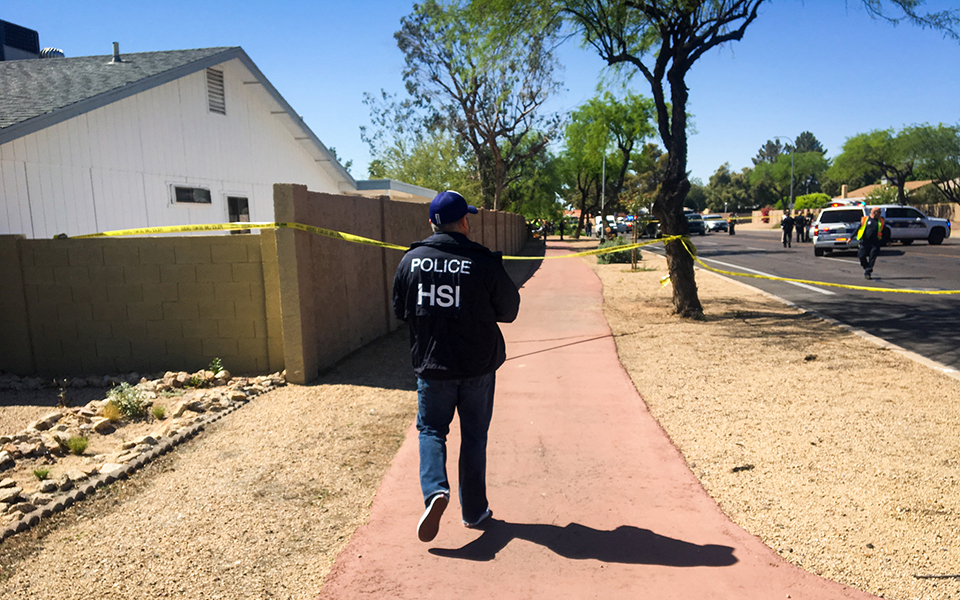

Federal law enforcement shootings have escaped the kind of scrutiny that gave rise to the local policing reforms of the Black Lives Matter movement.
Experts say that’s no accident: federal agencies are not transparent, making public oversight difficult.
One such agency is ICE’s Homeland Security Investigations, whose agents have been involved in shootings nationwide. Most of the victims have been black, Hispanic or Native American, according to the Howard Center for Investigative Journalism.
Published on Feb. 24, 2020
Agents were pursuing a suspected human smuggler when he took an unexpected turn into a community of neat stucco homes and walking trails. What followed sounded like “a war zone.”
Read more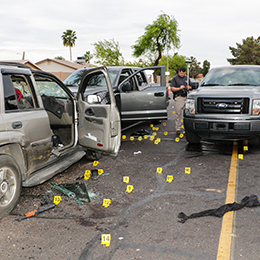
They thought the suspect’s SUV had only two occupants, although agents later acknowledged being unable to see through its dark tinted windows. Inside the SUV, tensions were rising.
Read more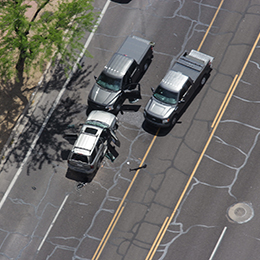
Warren Jose sat in the police interrogation room, in hospital gown and handcuffs, sinking forward with each ragged breath as he struggled to explain what happened in Ahwatukee.
Read more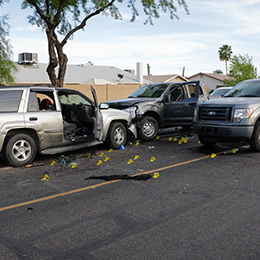
The mother of the slain woman struggles to understand why agents aren’t being held responsible for her death, as defense lawyers seek copies of HSI policies and procedures.
Read more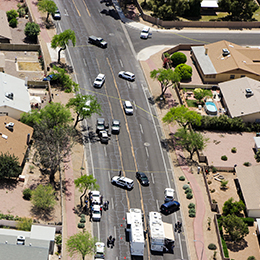
Efrain Torres swung open the brick-red wooden gate to his family’s northwest Chicago home and headed toward the back door after a night out with friends. In the predawn darkness, he heard voices behind him. “Felix, come here,” they said. “Come here, Felix.” Within minutes, his dad lay bleeding from an HSI agent’s gunshot, one of at least 14 agent-involved shootings nationwide.
Read moreArizona had the most agent-involved shootings, but cases were also reported around the country.
Agents from Homeland Security Investigations (HSI), a division of U.S. Immigration and Customs Enforcement, have killed, wounded or injured at least 16 people in shootings nationwide, most occurring in 2018-19, according to a review by the Howard Center for Investigative Journalism. Arizona had the most agent-involved shootings, but cases were also reported in at least eight other states. Most of the victims were black, Hispanic or Native American. No agent was charged in any of the shootings. Howard Center reporters pieced together details of the shootings using government records, obtained under public information requests, as well as court documents, lawsuits and interviews.
After a shootout in a Phoenix suburb involving federal agents of Homeland Security Investigations, a team of student reporters at the Howard Center for Investigative Journalism began examining use of force by federal law enforcement.
Police use of force at the local level has received much public scrutiny after a spate of shootings of unarmed black men, which gave rise to the Black Lives Matter movement and policing reforms. However, experts said, far less is known about federal use of force.
To understand the April 11, 2019, shooting in Ahwatukee Foothills, Arizona, involving HSI agents, the Howard Center filed a public records request with the Phoenix Police Department, which investigated the incident. The department ultimately released its 132-page incident report, audio from 22 recorded 911 calls, more than seven hours of video and audio footage gathered from police interviews with suspects, witnesses and federal agents, 3,465 crime scene photos and audio of the shooting captured by a home security system.
Reporters also obtained an autopsy and toxicology report on the driver of the suspect vehicle – the only person to die at the scene – who was not a subject of the manhunt. They shared that report with a forensic toxicologist at John Jay College of Criminal Justice for help with analysis.
The Howard Center asked two nationally renowned audio forensics and ballistics experts to analyze the audio of the shooting. Phoenix police said they did not have the technology to analyze the recording, which captured the sounds of sirens, vehicle crashes and gunfire, a 51-second period in which more than 100 shots were fired.
Steven Beck of Beck Audio Forensics in Austin, Texas, was a consultant for the FBI for 16 years and helped pioneer gunshot acoustics analytics. Rob Maher, an electrical and computer engineering professor at Montana State University, has spent decades researching gunshot acoustics and audio forensics. Both have been published internationally and have presented their studies at the Audio Engineering Society’s International Conferences on Audio Forensics.
Although they used different methodologies and computer programs to analyze the shooting audio, both experts concluded that a handgun was the first weapon fired. The police investigation found that only HSI agents had handguns, and the suspect fired a sawed-off AK-47 from inside his vehicle.
Beck reviewed the police incident report, in conjunction with the recording, to know the type of firearm and ammunition used by each shooter because, he said, each weapon produces a distinctive signature. Beck also considered the location of bullet casings, the distance between the home security system’s microphone and the shooting scene, the acoustic impact of nearby reflecting surfaces, such as concrete block walls, exterior walls of homes and the interior of the suspect’s SUV, as well as the effect the day’s gusty winds had on the microphone.
Maher took a different approach, saying he did not want his analysis to be biased by any information in the police report. After confirming the authenticity of the recording and distance from the home security system to the shooting scene, Maher said he examined the waveform and spectrogram of the recording, which helped him understand the duration of each gunshot, its frequency energy and sound amplitude. He said he also considered factors that could alter a gunshot’s sound, such as shooting direction, overlapping gunshots, reflecting surfaces and obstacles between the gunfire and microphone.
The Howard Center also filed multiple Freedom of Information Act requests to U.S. Immigration and Customs Enforcement, the parent agency of HSI, for shooting and other related data, use-of-force policies and copies of the internal reviews the agency says it conducts on every agent-involved shooting. ICE rejected the request for shooting data, which the Howard Center is appealing, and did not release any information on the Office of Professional Responsibility reviews. ICE provided an online link to its 2004 interim use-of-force policy, which was later removed from the agency’s website.
National experts on use of force and policing told reporters that because the U.S. government does not release its data, little is known about federal officer shootings. They warned that comparing the number of federal police shootings with those by local police officers would be misleading because their missions differ and local police have far more engagement with the public.
In the absence of such data, Howard Center reporters scoured news media archives for reports on other shootings and obtained the details of each case through public records, including those from police agencies, health departments, prosecutors and the courts. In all, reporters obtained more than 1,500 pages of official reports and court records, as well as interviewed family members of victims from around the country who had been involved in HSI shootings.
For background, reporters examined reports from the Office of Inspector General for the Department of Homeland Security, which oversees ICE and HSI, since 2016. They also studied use-of-force policies and reviews by outside groups, such as the Police Executive Research Forum, the International Association of Chiefs of Police, the U.S. Commission on Civil Rights and the American Civil Liberties Union. They consulted scholars on policing and the use of force and, when ICE and HSI officials refused to answer questions, reached out to the Federal Law Enforcement Officers Association, whose national president is a recently retired HSI agent.